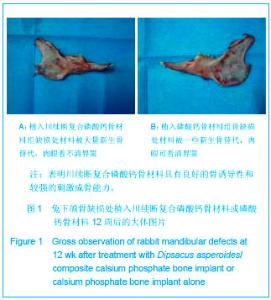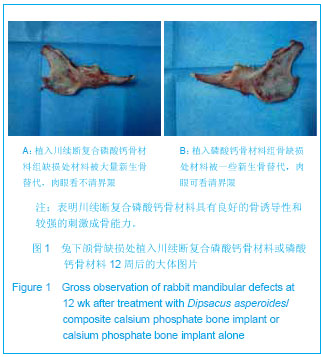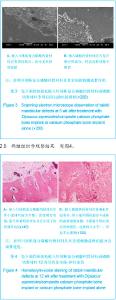Chinese Journal of Tissue Engineering Research
Previous Articles Next Articles
Dipsacus asperoides combined with composite calcium phosphate bone implant for bone defect repair
Li Shan-chang, Ren Yuan-yuan
- Department of Oral and Maxillofacial Surgery, Stomatological Hospital of Jiamusi University, Jiamusi 154002, Heilongjiang Province, China
-
Received:2013-03-11Revised:2013-04-13Online:2013-09-17Published:2013-09-17 -
Contact:Li Shan-chang, Chief physician, Department of Oral and Maxillofacial Surgery, Stomatological Hospital of Jiamusi University, Jiamusi 154002, Heilongjiang Province, China renyuanyuanjinan@126.com -
About author:Li Shan-chang★, Master, Chief physician, Department of Oral and Maxillofacial Surgery, Stomatological Hospital of Jiamusi University, Jiamusi 154002, Heilongjiang Province, China
CLC Number:
Cite this article
Li Shan-chang, Ren Yuan-yuan. Dipsacus asperoides combined with composite calcium phosphate bone implant for bone defect repair[J]. Chinese Journal of Tissue Engineering Research, doi: 10.3969/j.issn.2095-4344.2013.38.009.
share this article
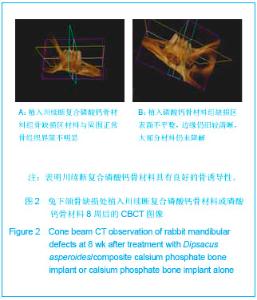
术后第2天多数兔已开始进食,查看术区无红肿无渗出,术后第4天开始术区缝合线逐渐脱落。术后4周,下颌骨缺损处混合材料表层盖有少许纤维结缔组织,实验组多于对照组。术后8周,实验组材料骨缺损区仅有中心部分有材料剩余,材料周围部分被新生骨代替,材料与周围骨组织的界限不清晰,无活动度;对照组骨缺损区材料剩余较多,与四周正常骨组织的界限较明显。术后12周,实验组骨缺损处材料被大量新生骨所替代,肉眼看不清界限,材料降解率明显高于对照组,硬度也明显高于对照组;随机抽取两组术后12周大体观察图片,见图1。 2.3 两组影像学观察结果 术后4周,实验组骨缺损区未见透射影像,材料与四周正常骨组织紧密结合,密度稍低于正常骨组织;对照组骨缺损区材料与四周骨组织的界限清晰,材料变化不明显。术后8周,实验组骨缺损区材料与周围正常骨组织界限不明显;对照组骨缺损区表面不平整,边缘仍旧较清晰,大部分材料仍未降解。术后12周,实验组骨缺损区材料由高密度影替代,材料与周围正常骨组织结合紧密,已属于骨性结合;对照组骨缺损处材料表面凹凸不平,边缘界限仍隐约可见,材料被不规则水滴状低密度影所替代;随机抽取两组术后8周CBCT图像,见图2。"
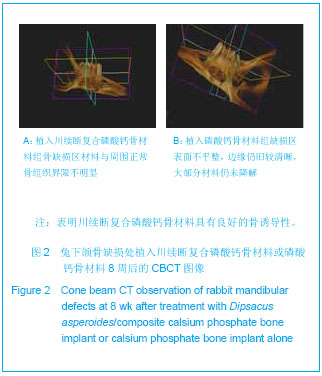
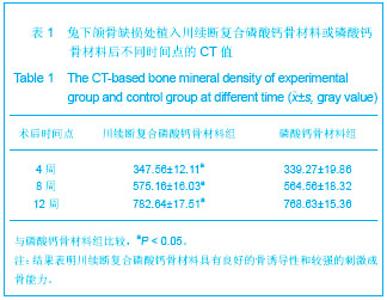
术后4周,实验组骨缺损处材料中由很多纤维性质的骨痂构成,大量成骨细胞分化增殖;对照组有少许成骨细胞分化增殖,新生骨量生长明显少于实验组。术后8周,实验组骨小梁数量及新生骨量明显增多,骨小梁表面围绕一层成骨细胞;对照组有少量骨痂形成,可明显看出部分材料的降解。术后12周,实验组骨小梁排列较为平整,密度明显增强,新生骨量明显增加并且出现了皮质骨样结构;对照组骨痂也开始明显增多,骨小梁周围有部分不成熟的成骨细胞包围,少量新生骨出现在骨缺损区,皮质骨大小不一,形态更是不太规则;随机抽取两组术后12周的苏木精-伊红染色图片,见图4。 2.6 两组CT骨密度灰度值分析结果 两组骨密度灰度值均随着时间的延长逐渐增大;术后4,8,12周两组的CT骨密度平均值见表1,经方差分析表明实验组术后4,8,12周的骨密度灰度值均高于对照组 (P < 0.05)。"
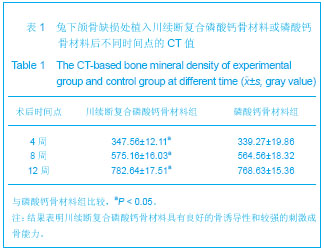
| [1] Sous M, Bareille R, Rouais F, et al. Cellular biocopatibility and resistance compression of macroporous beta-tricalcium phosphate ceramics. Biomaterials.1998;19(23): 2147- 2153. [2] Ganeles J,Listgarten MA,Evian CI. Ultrastructure of durapatite-periodontal tissue interface in human intrabony defects. J Periodontal.1986;57: 133-134. [3] Turnbull RS,Amler MH. Histological comparison of hydroxyapatite and betatricalcium phosphate implants in the rat parietal bone. J Dent Res.1985;64:218-219. [4] Szpalski M,Gunzburg R. Application of calcium phosphate-based cancellous bone void fillers on trauma surgery.Orthopedics.2002;25(5 Suppl): 597-600. [5] Wiltfang J,Merten HA,Schlegel KA,et al.Degradation characteristics of alpha and beta tri-calcium-phosphate (TCP) in minipigs.J Biomed Mater Res.2002;63(2):115-121. [6] Kishimoto M,Kanemaru S,Yamashita M,et al.Cranial bone regeneration using a composite scaffold of Beta-tricalcium phosphate, collagen, and autologous bone fragments. Laryngoscope.2006;116(2): 212-216. [7] Ogose A,Hotta T,Kawashima H,et al.Comparison ofhydroxy-apatite and beta tricalcium phosphate as bone substitutes after excision of bone tumors. J Biomed Mater Res B Appl Biomater. 2005;72(1):94-101. [8] Zerbo IR,Zijderveld SA,de Boer A,et al. Histomorphometry of human sinus floor augmentation using a porous beta-tricalcium phosphate: a prospective study. Clin Oral Implants Res.2004;15(6):724-732. [9] Zerbo I,Bronckers A,de Lange G,et al.Localization of osteogenic and osteoclastic cells in porous beta-tricalcium phosphate particles used for human maxillary sinus floor elevation. Biomaterials.2005;26(12): 1445-1451. [10] Suba Z,Takács D,Matusovits D,et al. Maxillary sinus floor grafting with beta-tricalcium phosphate in humans: density and microarchitecture of the newly formed bone. Clin Oral Implants Res.2006;17(1): 102-108. [11] 王家葵,王一涛.续断功效与临床应用历史沿革考[J].中医杂志, 1992,33(6):49-50. [12] 张万福.五鹤续断的地道历史考证[J].中国中药杂志,2003, 28(11): 1100-1101. [13] 国家药典委员会.中华人民共和国药典(一部)[S].北京:中国医药科技出版社,2010. [14] 谭洪根,林生,张启伟,等.高效液相色谱法测定续断药材中川续断皂苷Ⅵ的含量[J].中国中药杂志,2006,31(9): 726-727. [15] 丁莉,武芸.五鹤续断部分生物学特征及栽培管理研究[J].湖北民族学院学报:自然科学版,2005,23(2):144-146. [16] 李燕立,艾铁民,傅桂芳.中药续断显微鉴定研究[J].中国中药杂志,1993,18(5):265-268 [17] 武芸,丁莉,韩鸿,等.五鹤续断愈伤组织的诱导和增殖[J].安徽农业科学,2009,37(13):5877-5878. [18] 武芸,武王莲,张泽,等.五鹤续断快繁体系的建立和优化[J].时珍国医国药,2010,21(4):988-989. [19] Tian XY,Wang YW,Liu XK,et al. On the chemical constituents of Dipsacus asper. Chem Pharm Bull (Tokyo). 2007;55(12): 1677-1681. [20] Hung TM, Na M, Thuong PT,et al. Antioxidant activity of caffeoyl quinic acid derivatives from the roots of Dipsacus asper Wall. J Ethnopharmacol. 2006;108(2):188-192. [21] 纪顺心,吴雪琴,李崇芳.中药续断对大鼠实验性骨损伤愈合作用的观察[J].中草药,1997,28(2):98-99. [22] 张海亮,随丽娜.多孔羟基磷灰石生物活性玻璃修复兔颌骨缺损[J].医药论坛杂志,2007,28(8):26-27. [23] Schlegel KA,Fichtner GF,Schultze-Mosgau S,et al.Histologic findings in sinus augment with autogenous bone chips versus a bovine bone substitute.Int J Oral Maxillofac Implants.2003; 18:53-58. [24] Lee JH,Kim MJ,Choi WS,et al.Concomitant reconstruction of mandibular basal and alveolar bone with a free fibular flaP.Int J Oral Maxillofac Sufg.2004;33:150-156. [25] Monroe EA.New calcium phosphate ceramic material for Bone and tooth implants.J Dent Res.1971;12(6):50-51. [26] Bragnces CR,Burke D,Lowenstein JD,et al. Differences in stiffness of the interface between a cementless porous implant and cancellous bone in vivo in dogs due to varying amounts of implant motion.Arthroplasty. 1996;11(10): 945-951. [27] Franchi M,Bacchelli B,Martini D,et al.Early detachment of titanium particlesfrom various different surfaces of endosseous dental implants. Biomaterials. 2004; 25(6): 2239-2246. [28] 程志安,吴燕峰,黄智清,等.续断对成骨细胞增值、分化、凋亡和细胞周期的影响[J].中医正骨,2004,16(12):705-707. [29] Liu ZG,Zhang R,Li C,et al.The osteoprotective effect of Radix Dipsaci extract in ovariectomized rats.J Ethnophaimacol. 2009;123:74-81. [30] 郭昭庆,党耕町,王志国.氟化钠及续断组分对成骨细胞增殖的影响[J].中华骨科杂志,1998,18(2):84. [31] 龚小健,吴知行,陈真,等.川续断对离体子宫的作用[J].中国药科大学学报,1995,26(2):115. [32] 王磊,张梅,王旭霞,等.中药川续断促进再生牙周对正畸力反应的研究[J].山东大学学报,2011,49(11):15-20. [33] 郑志永.续断苷对人成骨细胞增殖和分化作用研究[J].山东中医药大学学报,2006,30(5):388-389. |
| [1] | Fan Jiabing, Zhang Junmei. Morphological measurement and analysis of the mandible in adult females with different vertical skeletal types [J]. Chinese Journal of Tissue Engineering Research, 2021, 25(8): 1177-1183. |
| [2] | Cheng Bingkun, Liang Jianfei, Qin Dongze, Cheng Zixu, Zhao Yunzhuan. Isolation, culture and biological characteristics of high-purity orofacial-bone-derived mesenchymal stem cells of the rats [J]. Chinese Journal of Tissue Engineering Research, 2021, 25(1): 67-72. |
| [3] | Dong Wenjie, Zhang Shiyang, Zhao Lei, Wang Yukun. Icariin deproteinized inorganic bovine bone composite and deproteinized inorganic bovine bone material in repairing mandibular defects [J]. Chinese Journal of Tissue Engineering Research, 2020, 24(34): 5467-5472. |
| [4] | Wu Min1, Li Xue1, Gao Jie1, Yang Shuai1, Cai Yizhi2, Wang Mingguo1 . Micro-CT changes and vascular endothelial growth factor expression in reconstructed mandibular condylar cartilage under continuous mandibular advancement in growing and adult rats [J]. Chinese Journal of Tissue Engineering Research, 2019, 23(7): 1001-1006. |
| [5] | Yuan Bo, Wang Zhiwei, Tang Yifan, Zhou Shengyuan, Chen Xiongsheng, Jia Lianshun. Construction of polycaprolactone-tricalcium phosphate with different mixture ratios using three-dimensional printing technology and its osteoinductivity in vitro [J]. Chinese Journal of Tissue Engineering Research, 2019, 23(6): 821-826. |
| [6] | Wang Xuefeng, Shang Xifu . Curative effects of three filling materials in the treatment of osteoporotic thoracolumbar fractures [J]. Chinese Journal of Tissue Engineering Research, 2019, 23(6): 863-869. |
| [7] | Liu Dan, Min Changqin, Lu Shuai, Chen Yue, Sun Yong. Osseointegration induced by beta-tricalcium phosphate loaded with advanced platelet-rich fibrin [J]. Chinese Journal of Tissue Engineering Research, 2019, 23(6): 888-893. |
| [8] | Cheng Jian, Zhang Jun, Guan Jie, Zeng Junkai, Zhao Xin, Xie Youzhuan. Silver nanoparticle-doped tricalcium phosphate: in vitro and in vivo toxicity in rabbits [J]. Chinese Journal of Tissue Engineering Research, 2019, 23(6): 917-923. |
| [9] | Luo Dongyuan1, Zhou Niangou2, Chen Yiyang1, Wang Hongtao1, Li Fan1, Wu Wenli1, Liu Jiayu1, Hao Jiansuo1. Body weight changes in children with Pierre Robin syndrome after distraction osteogenesis [J]. Chinese Journal of Tissue Engineering Research, 2019, 23(31): 4927-4931. |
| [10] | Wei Wei, Liu Yanfei, Zhang Ling, Xiong Na . Self-assembling peptide hydrogel: hemostatic effect and mechanism [J]. Chinese Journal of Tissue Engineering Research, 2019, 23(2): 310-316. |
| [11] | Cui Tingting, Qiu Zewen, Gui Lin, Zhong Weijian, Ma Guowu. Effect of gelatin sponge/beta-tricalcium phosphate composite with different doses of basic fibroblast growth factor on bone regeneration [J]. Chinese Journal of Tissue Engineering Research, 2019, 23(2): 190-195. |
| [12] | Gao Shan, Zhou Fang, Lü Yang, Yuan Liang, Li Ailing, Qiu Dong. Preparation and characterization of novel porous polymethyl methacrylate bone cements [J]. Chinese Journal of Tissue Engineering Research, 2019, 23(2): 204-210. |
| [13] | Zhou Yang, Zhou Libin, Piao Zhengguo. Prospects and application of curvilinear distraction osteogenesis [J]. Chinese Journal of Tissue Engineering Research, 2019, 23(15): 2436-2442. |
| [14] | Peng Chenjian, Du Bin, Sun Guangquan, Liu Xin, Xue Peng, Cao Liangquan. Three-dimensional printing beta-tricalcium phosphate scaffold loaded with icariin particles for repairing osteonecrosis of the femoral head in rabbits [J]. Chinese Journal of Tissue Engineering Research, 2019, 23(14): 2162-2168. |
| [15] | Li Haoliang, Wang Xibin, Zuo Ruiting. Calcium phosphate cement/fibrin glue composite loaded with recombinant human bone morphogenetic protein 2 promotes osteoporotic fracture healing [J]. Chinese Journal of Tissue Engineering Research, 2019, 23(14): 2156-2161. |
| Viewed | ||||||
|
Full text |
|
|||||
|
Abstract |
|
|||||
